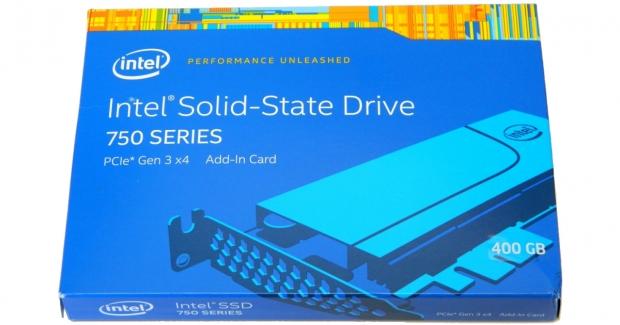
The Bottom Line
Introduction, Drive Specifications, Pricing and Availability

NVMe (Non-Volatile Memory Express) technology is transforming SSD's as we know them. NVMe is a protocol built for current and future non-volatile storage solutions. Designed specifically for solid-state non-volatile memory, NVMe is revolutionary because it lowers latency and CPU overhead with a streamlined command stack. NVMe is a standard specification that provides a massive improvement in both random and sequential performance in comparison to the dated legacy AHCI protocol of SATA based SSD's. Our testing has shown that a single NVMe drive can provide performance equivalent to or greater than a 6-drive SATA array. NVMe allows for greater queue depths, higher levels of parallelism and much higher IOPS than AHCI.
Intel's 750 Series SSD's are currently the only client-based NVMe drives available through normal retail channels. Intel's 750 Series SSD's are available in two form factors, a HHHL AIC (Half Height Half Length Add-In-Card) PCIe slot SSD or a 2.5"x 15mm SSD with an 8639 connector. The 750 Series employs no power saving measures, its enterprise DNA is all about raw power and high IOPS making it a desktop enthusiast's dream. We previously tested the 1.2 TB 750 series drive and the only knock against it is a $1000 price tag. Most consumers are unwilling to dish out a thousand bucks for storage, no matter how well it performs. Fortunately, Intel has a 400GB version priced within the reach of most desktop enthusiasts. Priced at just $1 per gigabyte, the 400GB 750 Series SSD is generating a lot of interest in the Enthusiast community.
Speaking of the Enthusiast community, Gamers listen up. When talking with TweakTown's in-house video card expert Anthony Garreffa, he informed me that hard core gamers are finding that there is a distinct advantage when running an Intel 750 Series SSD as a gaming SSD. Generating textures in real time is very taxing on any storage device, and this is where a 750 Series SSD gives you a huge performance boost. Generating textures from a 750 Series SSD is insanely fast, so the world literally generates before your eyes, so much faster than it does with a SATA SSD, it will make your head spin. In the near future, Anthony and I will be working up a test to show the impact a good PCIe NVMe SSD will make on your gaming experience.
As most of you know, we believe that providing results with the drives running as our boot volume 75% full is far more relevant than providing you with results from empty SSD's in an FOB or lightly used state. Testing boot volumes also allows us to comment with authority on how the drive/array handles when used as you will be using it. This method of testing takes more time and effort, but we believe it is well worth it.
Let's get going and see for ourselves what level of performance can be expected from Intel's affordable 400GB NVMe consumer SSD.
Specifications Intel 750 400GB NVMe SSD
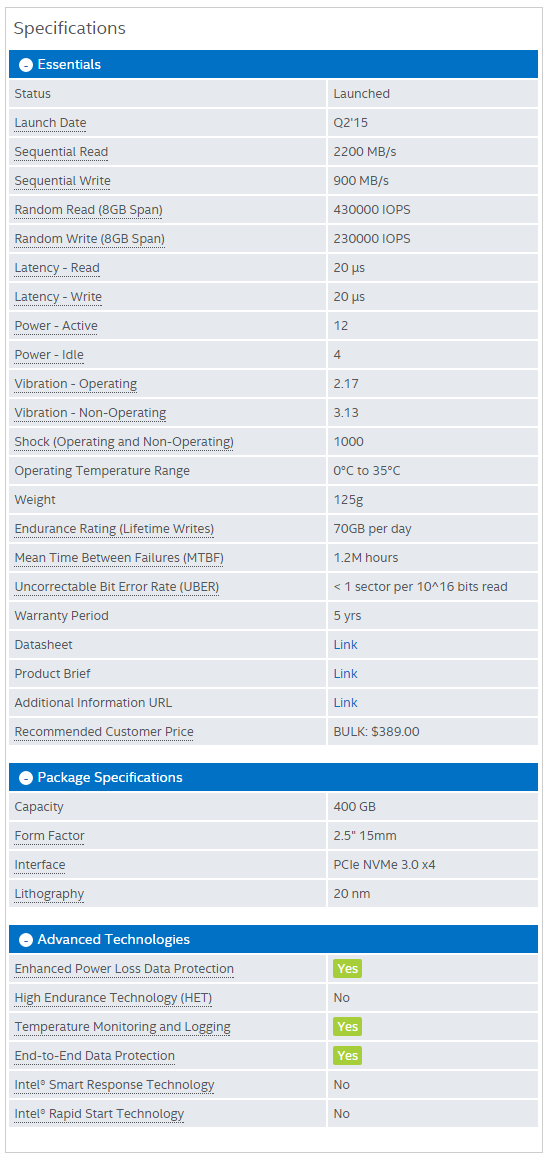
Intel's 750 Series SSD is available in two capacities 400GB and 1.2TB. Both capacities are available in two form factors, a half-length, half-height AIC with a single slot x4 connector and a 2.5" x 15mm Z-height standard form factor with an 8639-compatible connector. Sequential R/W performance for the 400GB 750 is listed at 2200/900 MB/s. 4K random read performance is listed at up to 430,000 IOPS. 4K random write performance is listed at up to 230,000 IOPS. Both available form factors (AIC & 2.5") carry identical performance ratings.
Enhanced power-loss protection is provided by onboard capacitors. Data protection is enhanced by up to 32GB of the drives memory dedicated to XOR internal data parity. Endurance is rated at up to 70GB per day or 219 TBW (Terabytes Written). Power consumption is listed at 12W active / 4W idle. The 400GB drive has a MSRP of $389 and the 1.2TB drive $1029. Intel backs the 750 series with a five-year limited warranty.
Drive Details
Drive Details - Intel 750 1.2TB NVMe PCIe Gen3 x4 AIC SSD
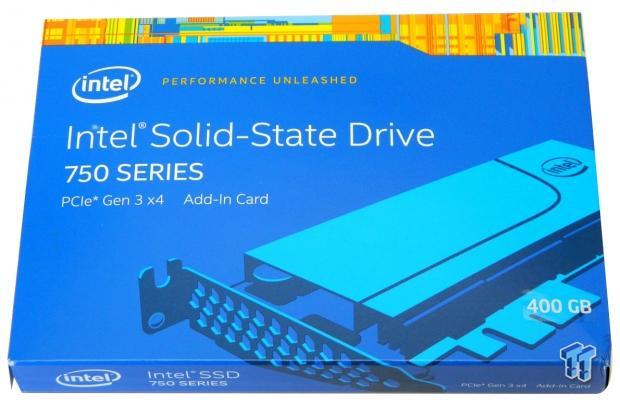
In typical Intel fashion, the drive ships in an attractive, protective package. The front of the mostly blue box lists the drive model, capacity and sports a depiction of the drive within.
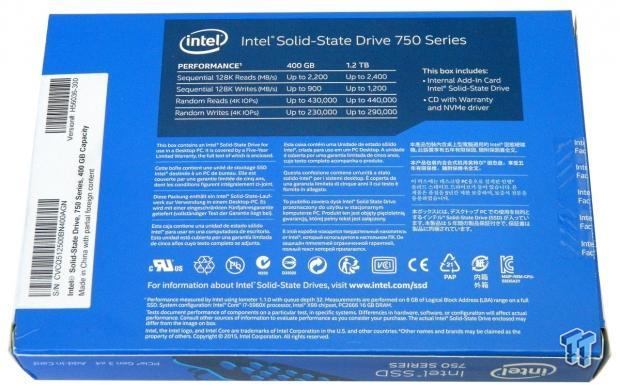
The back of the blue colored packaging lists sequential and random 4k performance specifications, model and serial number of the drive contained within.
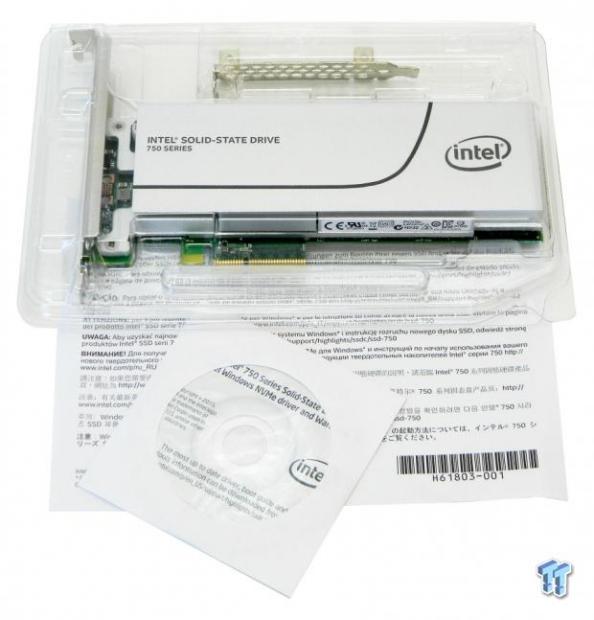
Here are the contents. The drive is well protected inside a clear plastic clamshell container. Included is a half-height bracket and a CD with warranty information and Intel's proprietary NVMe driver.
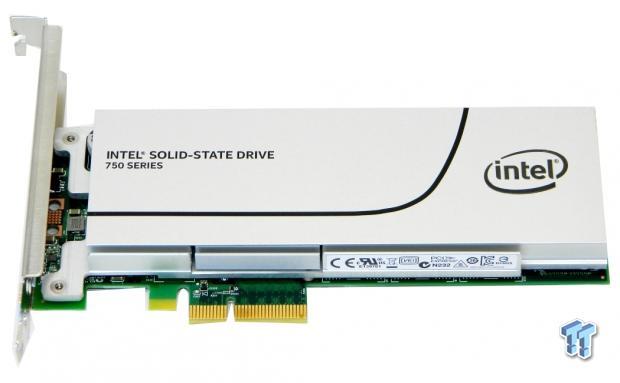
The AIC version of the 750 series SSD we are reviewing has a full-length aluminum heat sink that covers the top half of a single PCB. There are aluminum channels and fins covered by a thin sheet aluminum facing emblazoned with an Intel logo, a trademark swoop and the model of the drive.
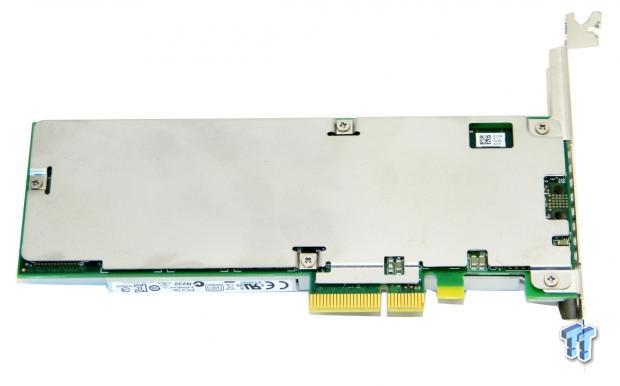
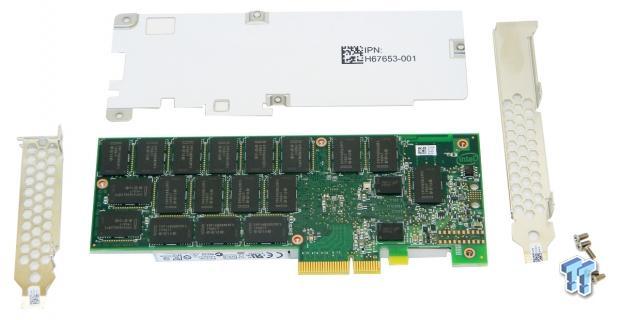
The bottom of the drives PCB is shielded by a piece of sheet aluminum. Removing the sheet metal shield exposes the bottom half of the drive's PCB. The half of the PCB we exposed is populated with 18-BGA packaged flash chips and two DDR3 1600MHz CL11 DRAM packages. We tried to remove the heat sink, but that was a no-go; even with the screws removed, the heat sink was still firmly attached so we did not force the issue. The unseen half of the PCB is populated by a single proprietary Intel PCIe controller in a 9-channel configuration, an additional (18) 20nm Flash IC's and three more DRAM packages.

Looking down through the middle channel of the heat sink and under the sheet aluminum facing, we can get a glimpse of an additional heat sink that dissipates heat generated by the drive's controller. Intel recommends a minimum airflow of 100LF per minute pass through these channels to keep the drive cooled.
Test System Setup and Properties
Test System Configuration

We would like to thank the following companies: ASRock, Crucial, Intel, Corsair, RamCity, IN WIN, and Seasonic for making our test system possible.
Drive Properties
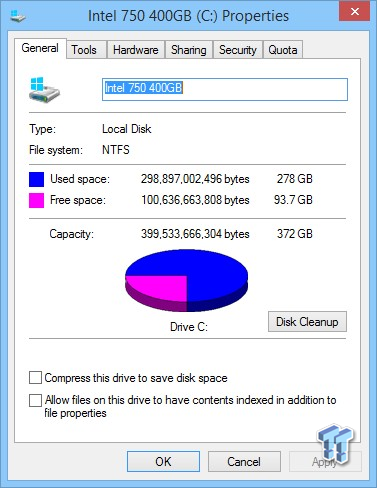
The majority of our testing is performed with our test drive as our boot volume. Our boot volume is 75% full for all OS Disk "C" drive testing to replicate a typical consumer OS volume implementation. We feel that most of you will be utilizing SSD's for your boot volume and that presenting you with results from an OS volume is more relevant than presenting you with empty secondary volume results.
System settings: Cstates and Speed stepping are both disabled in our systems BIOS. Windows High Performance power plan is enabled. Windows write caching is enabled, and Windows buffer flushing is disabled. We are utilizing Windows 8.1 64-bit for all of our testing except for our MOP (Maxed-Out Performance) benchmarks where we switch to Windows Server 2008 R2 64 Bit.
Synthetic Benchmarks - ATTO & Anvil Storage Utilities
ATTO
Version and / or Patch Used: 2.47
ATTO is a timeless benchmark used to provide manufacturers with data used for marketing storage products.
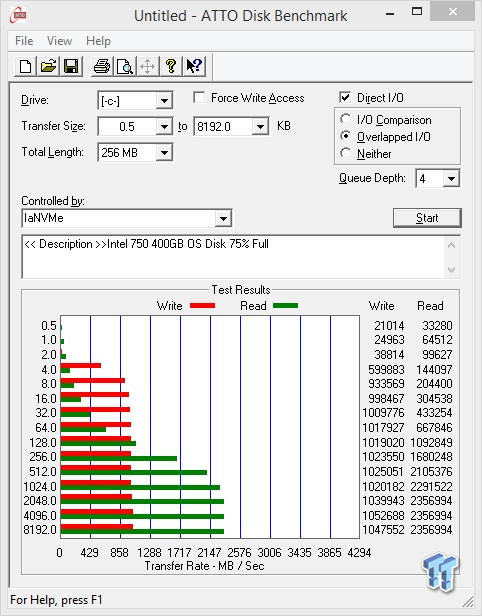
Sequential read transfers max out at 2.25 GB/s. Sequential write transfers max out at 1.00 GB/s.
Sequential Write
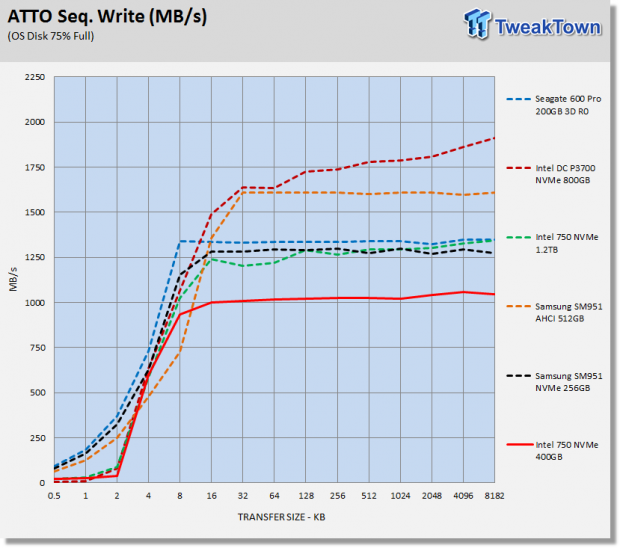
A gigabyte per second is very fast, but it's still the lowest maximum sequential write performance on our chart.
Sequential Read
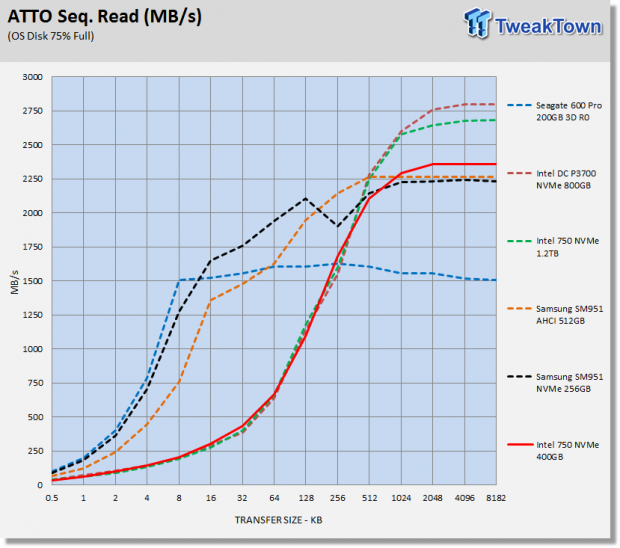
We would like to see better small file sequential performance from the Intel drives. Our 3-drive array and both Samsung PCIe drives have much better small file sequential performance. The 750 Series drives are able to surpass both Samsung PCIe drives at a 1024k sequential transfer size and our array at 256k sequential transfers.
Anvil Storage Utilities
Version and / or Patch Used: 1.1.0
Anvil's Storage Utilities is a storage benchmark designed to measure the storage performance of SSD's. The Standard Storage Benchmark performs a series of tests; you can run a full test or just the read or write test, or you can run a single test, i.e. 4k QD16.
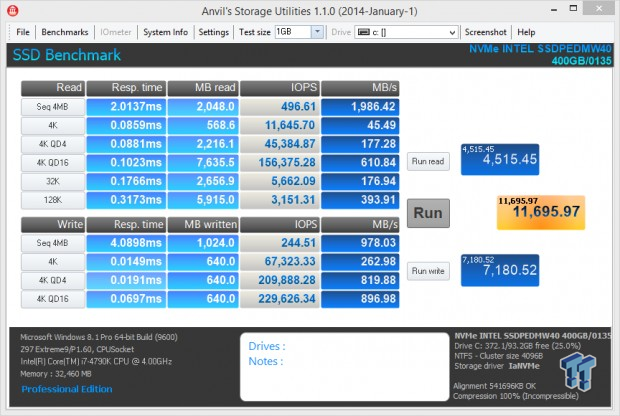
Scoring

Random read performance up to QD16 is dominated by the Samsung NVMe drive, which is reflected by its very high read score. Random write performance is where the Intel's NVMe drives have a big performance advantage over Samsung's OEM PCIe SSD's.
(Anvil) Read IOPS through Queue Depth Scale
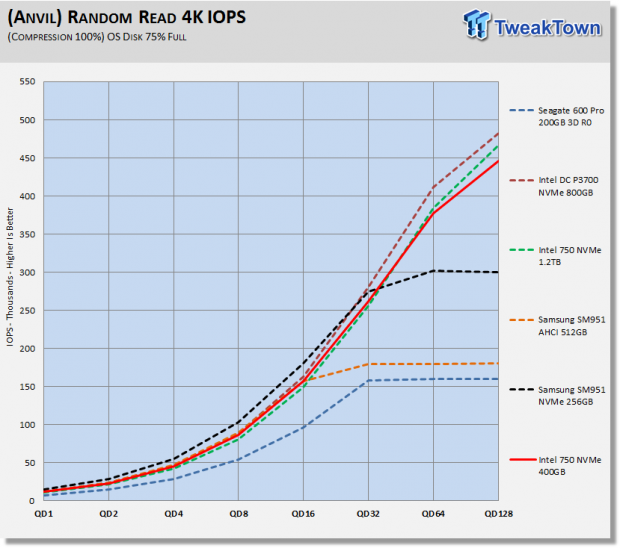
Samsung's NVMe SSD has the advantage at QD1-32, at higher queues Intel's 750 Series SSD's distance themselves from the rest of the field.
(Anvil) Write IOPS through Queue Scale
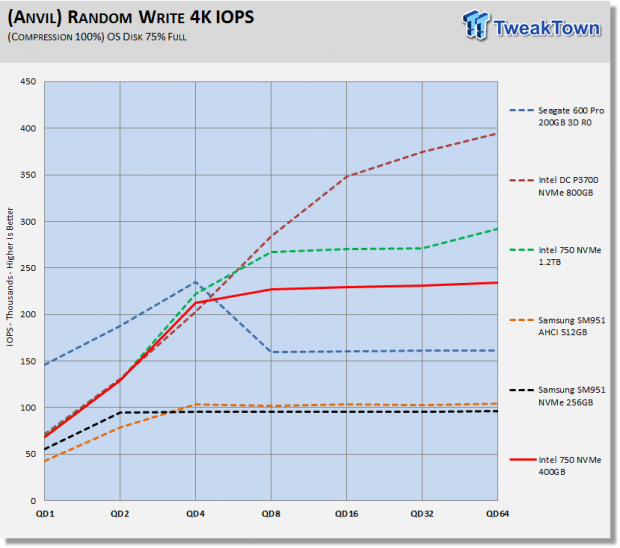
At QD1-4 our 600 Pro array easily outperforms the PCIe drives. From there, the Intel drives leave everyone in the dust.
Synthetic Benchmarks - CrystalDiskMark & AS SSD
CrystalDiskMark
Version and / or Patch Used: 3.0 Technical Preview
CrystalDiskMark is disk benchmark software that allows us to benchmark 4k and 4k queue depths with accuracy. Note: Crystal Disk Mark 3.0 Technical Preview was used for these tests since it offers the ability to measure native command queuing at QD4.
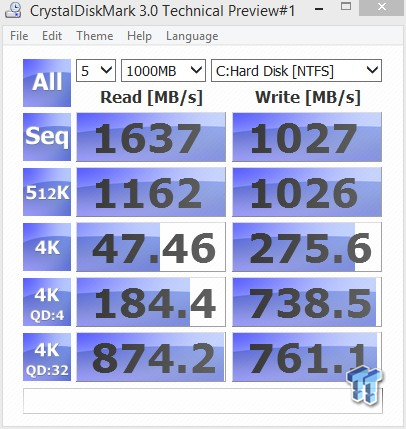
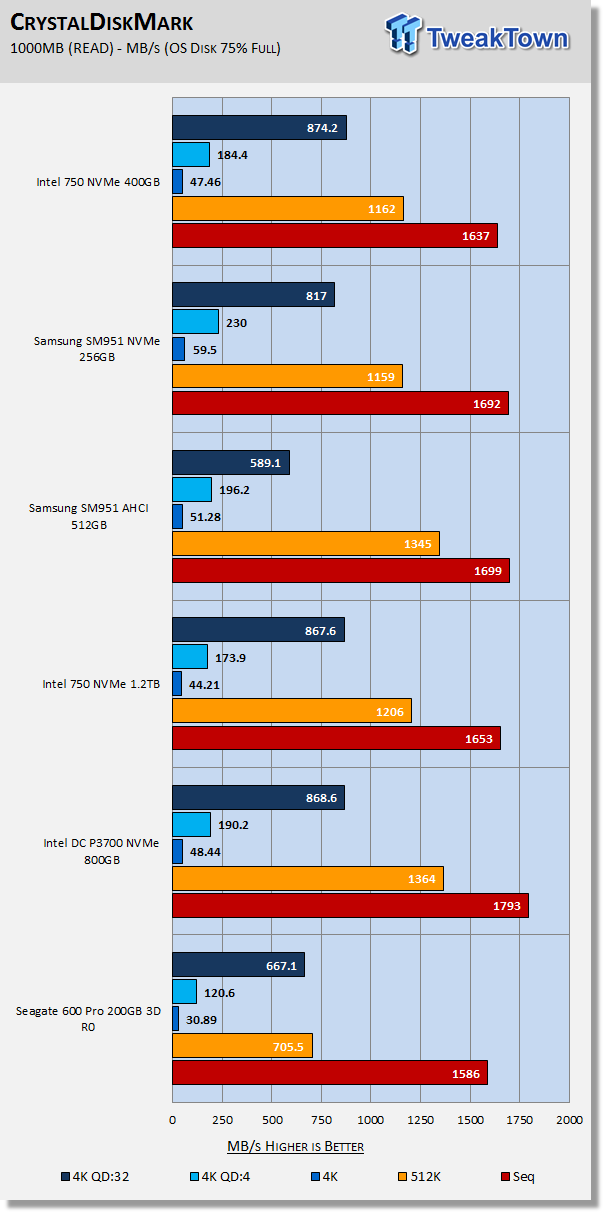
Let's focus on 4K QD1 and 4K QD4 because they are the two most important categories. This is where the 400GB 750 has an advantage over the 1.2 TB version. Fewer die counts tend to be faster at low queue depths and this is what we are seeing here. This is our first indicator that the 400GB version may have superior performance in comparison to the 1.2TB version in an OS environment where low QD random read performance has the most impact. We also note that the 400GB 750 has better random read performance at QD32 in this test than the rest of the drives on our chart.
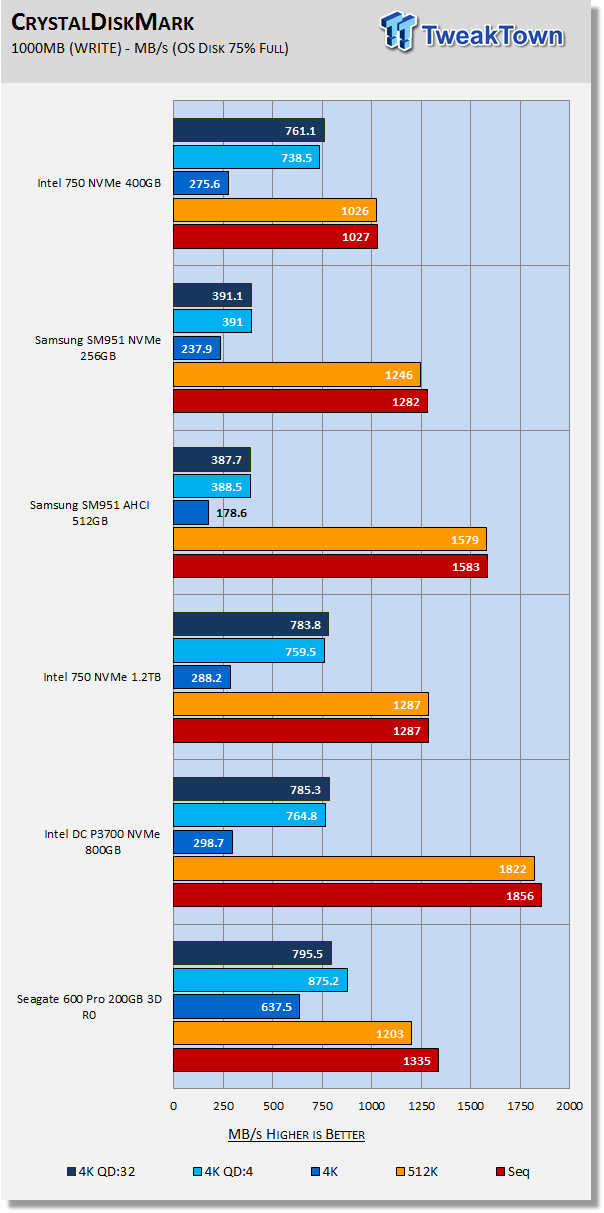
Not surprisingly, the 1.2TB 750 has better write performance than the 400GB 750. Our array has the best random performance and the DC P3700 the best sequential performance.
AS SSD
Version and / or Patch Used: 1.7.4739.38088
AS SSD determines the performance of Solid-State Drives (SSD). The tool contains four synthetic as well as three practice tests. The synthetic tests are to determine the sequential and random read and write performance of the SSD.
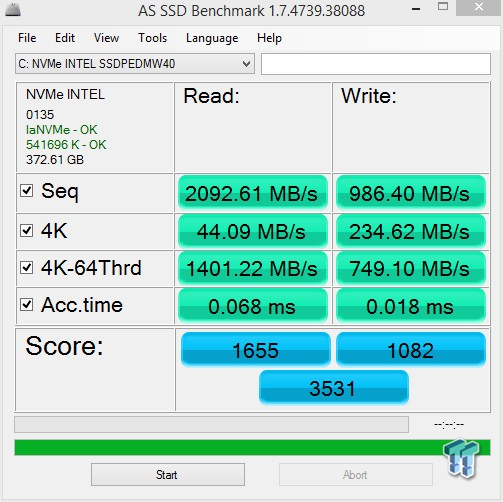
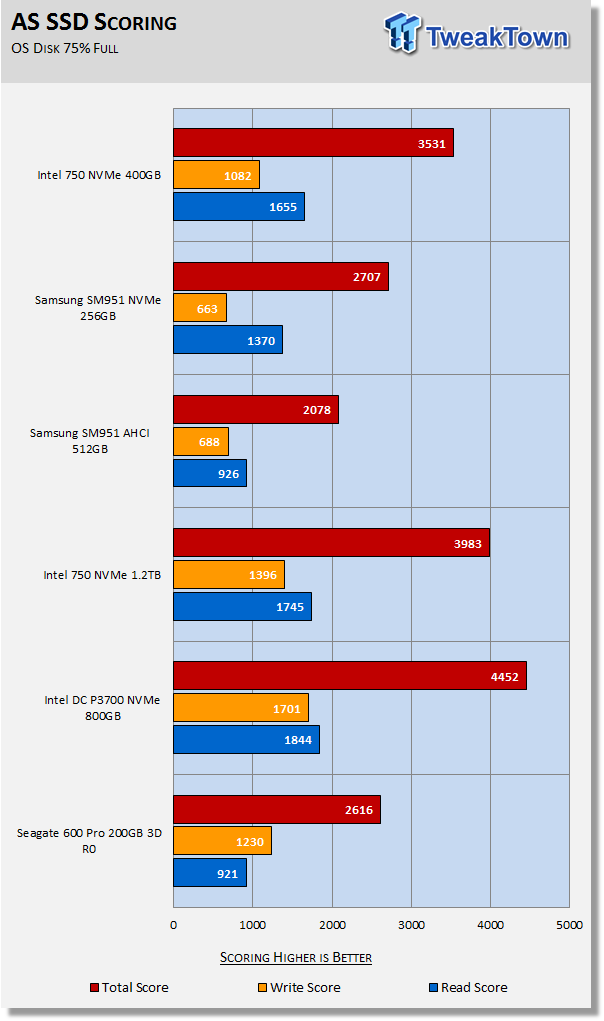
AS SSD scoring can be a bit misleading because so much of the score is based on 4k QD64 (4k-64 Thrd) throughput. An OS will rarely reach 64 queues. With our synthetic testing out of the way, let's get to some real-world testing and see how our 400GB 750 Series SSD performs with more realistic benchmarks.
Benchmarks (Trace Based OS Volume) - PCMark Vantage, PCMark 7 & PCMark 8
Moderate Workload Model
We categorize these tests as indicative of a moderate workload environment.
PCMark Vantage - Hard Disk Tests
Version and / or Patch Used: 1.2.0.0
The reason we like PCMark Vantage is because the recorded traces are played back without system stops. What we see is the raw performance of the drive. This allows us to see a marked difference between scoring that other trace-based benchmarks do not exhibit. An example of a marked difference in scoring on the same drive would be empty vs. filled vs. steady state.
We run Vantage three ways. The first run is with the OS drive 75% full to simulate a lightly used OS volume filled with data to an amount we feel is common for most users. The second run is with the OS volume written into a "Steady State" utilizing SNIA's guidelines. Steady state testing simulates a drives performance similar to that of a drive that been subjected to consumer workloads for extensive amounts of time. The third run is a Vantage HDD test with the test drive attached as an empty, lightly used secondary device.
OS Volume 75% Full - Lightly Used
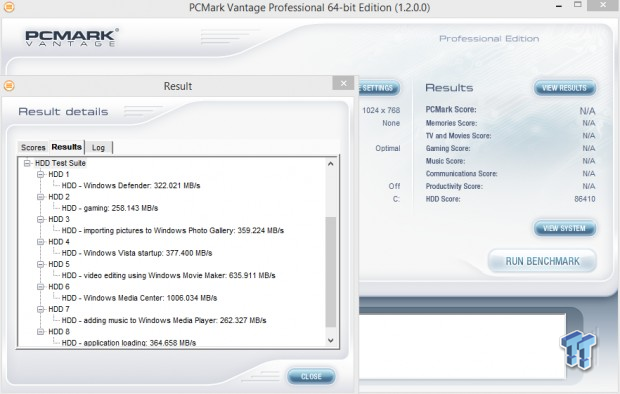
OS Volume 75% Full - Steady State
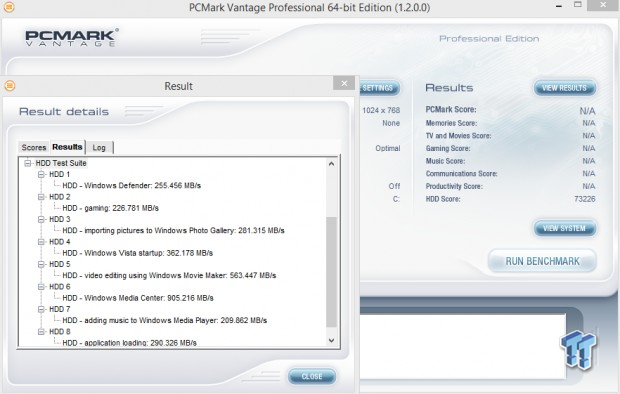
Secondary Volume Empty - FOB
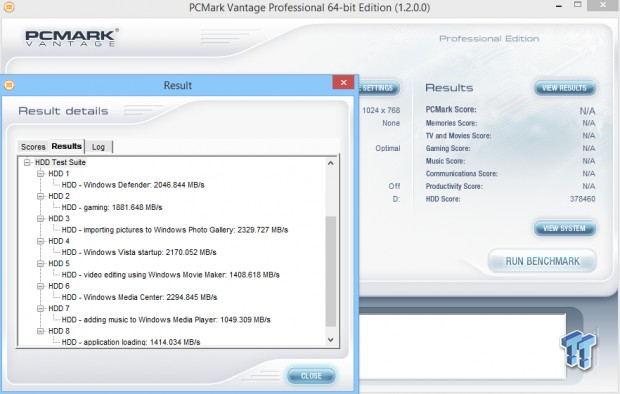
There's a big difference between an empty drive, one that's 75% full/used, and one that's in a steady state.
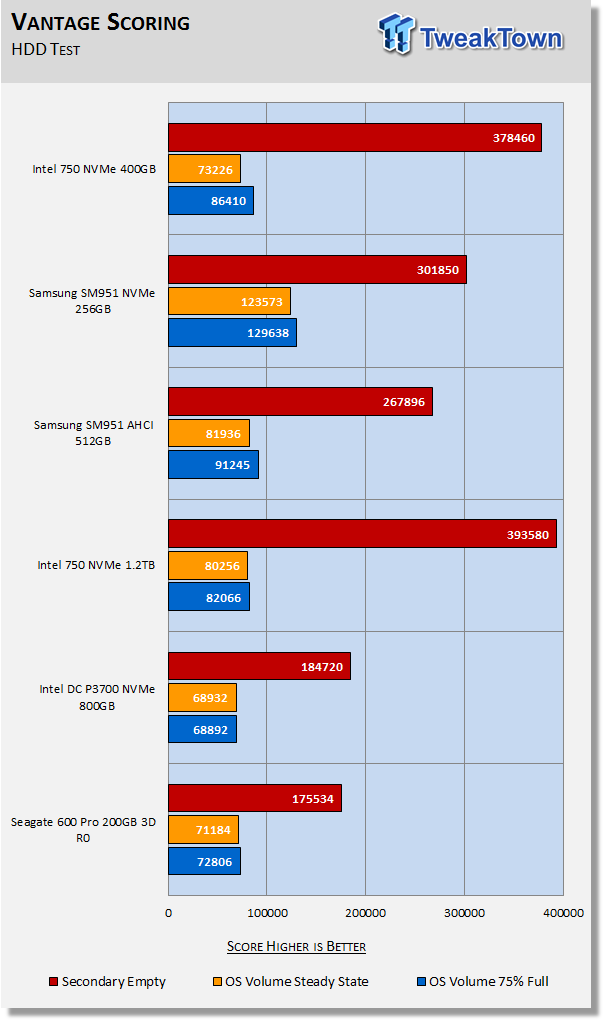
The important scores to pay attention to are "OS Volume Steady State" and "OS Volume 75% full." These two categories are most important because they are indicative of typical of consumer user states. When a drive is in a steady state, it means garbage collection is running at the same time it's reading/writing. This is exactly why we focus on steady state performance.
Better low queue random performance allows the SM951-NVMe to deliver the best performance in this test. The 400GB 750 has the best performance of the Intel drives in a lightly used state, but the 1.2TB 750 delivers more performance than the 400GB version in a steady state.
PCMark 7 - System Storage
Version and / or Patch Used: 1.4.0
We will look to Raw System Storage scoring for an evaluation because it's done without system stops and therefore allows us to see significant scoring differences between drives.
OS Volume 75% Full - Lightly Used
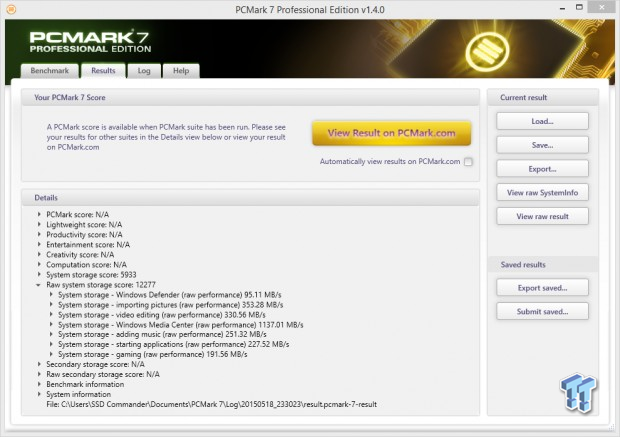
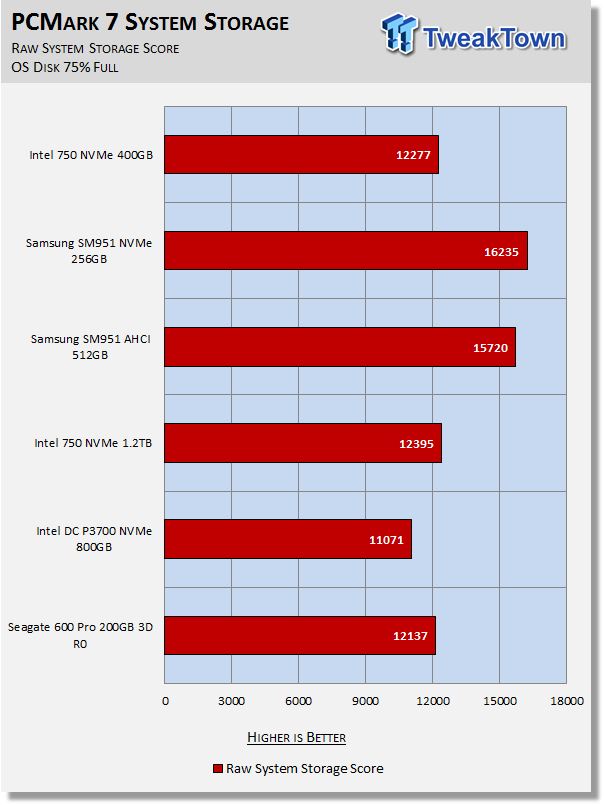
The 400GB 750 is basically delivering the same performance as the 1.2TB 750. The Samsung PCIe drives with their superior low QD random read performance easily outperform the Intel PCIe drives in this test.
PCMark 8 - Storage Bandwidth
Version and / or Patch Used: 2.4.304
We use PCMark 8 Storage benchmark to test the performance of SSDs, HDDs, and hybrid drives with traces recorded from Adobe Creative Suite, Microsoft Office, and a selection of popular games. You can test the system drive or any other recognized storage device, including local external drives. Unlike synthetic storage tests, the PCMark 8 Storage benchmark highlights real-world performance differences between storage devices.
OS Volume 75% Full - Lightly Used
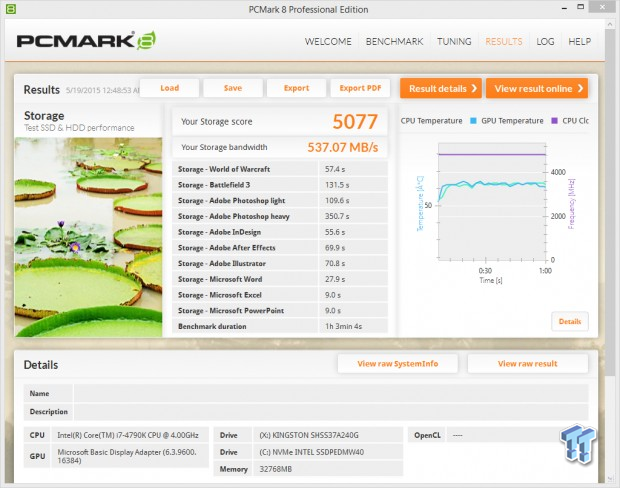
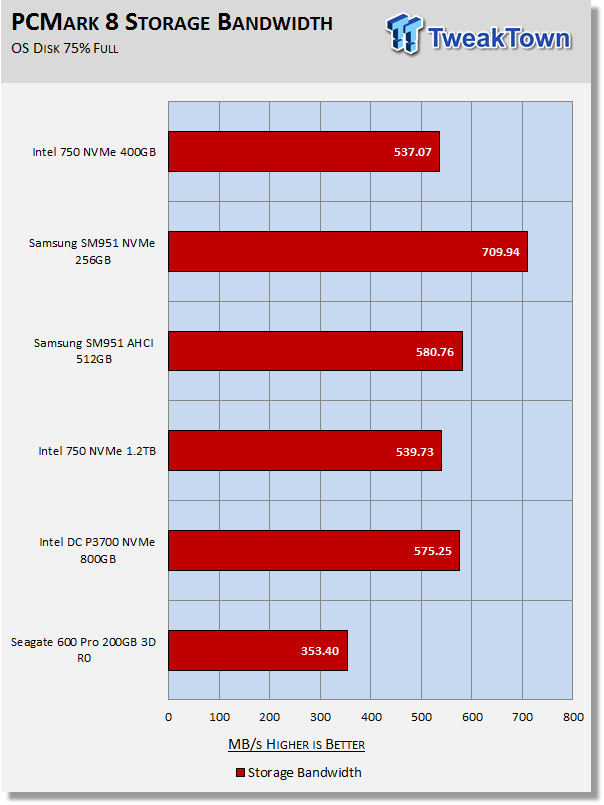
PCMark 8 is the most intensive moderate workload simulation we run. The 400GB 750 is performing at the same level as the 1.2TB 750. What we can take away from our moderate workload testing is that in a typical enthusiast OS setting the 400GB 750 Series is every bit as fast as the 1.2TB, despite its lower sequential read/write speeds.
Benchmarks (Secondary Volume) - Max IOPS, Disk Response & Transfer Rates
Iometer - Maximum IOPS
Version and / or Patch Used: Iometer 2014
We use Iometer to measure high queue depth performance.
Max IOPS Read
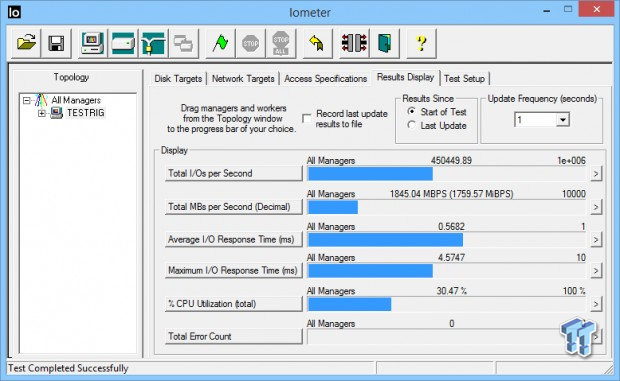
Max IOPS Write
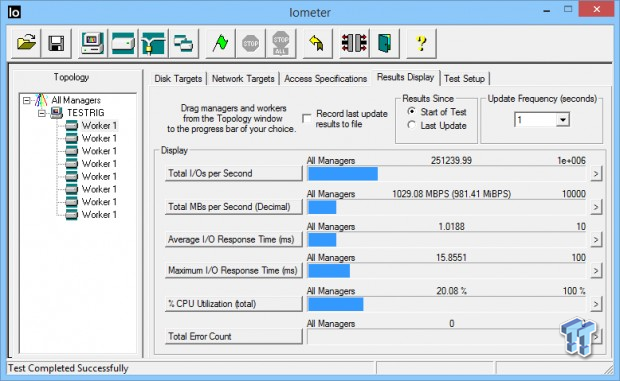
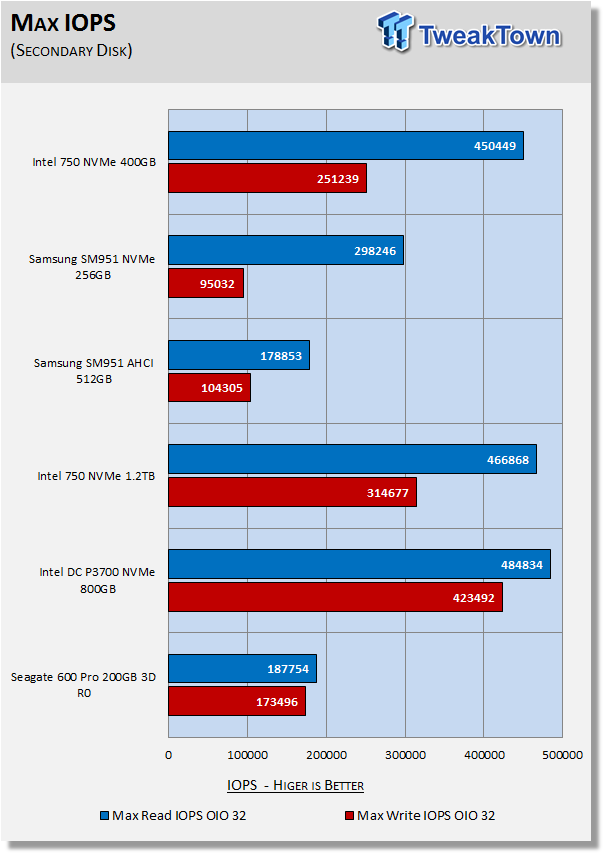
We are able to easily exceed Intel's maximum random 4k IOPS specifications of 430K/230K. The 400GB 750 is a real powerhouse.
Iometer - Disk Response
Version and / or Patch Used: Iometer 2014
We use Iometer to measure disk response times. Disk response times are measured at an industry accepted standard of 4K QD1 for both write and read. Each test runs twice for 30 seconds consecutively, with a 5-second ramp-up before each test. We partition the drive/array as a secondary device for this testing.
Avg. Write Response
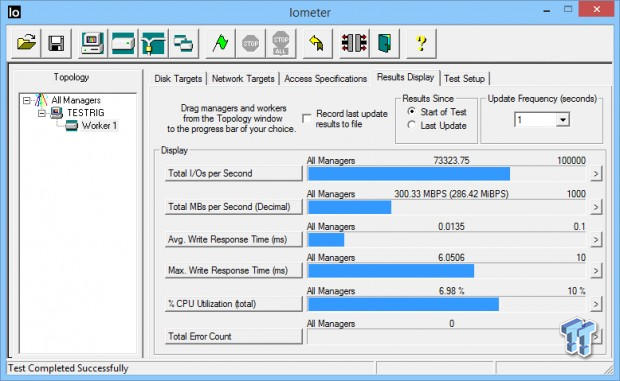
Avg. Read Response
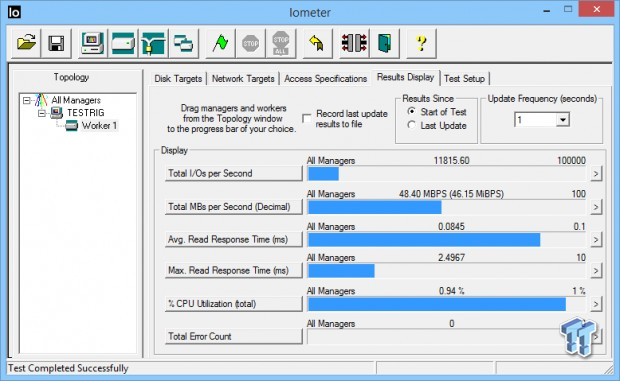
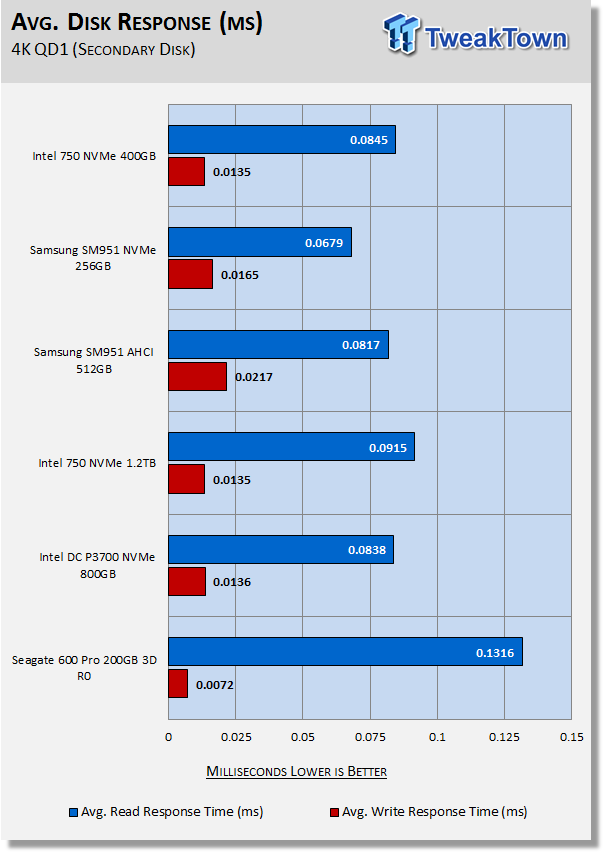
Take a look at the read response times of the 400GB 750; it is significantly better than the 1.2TB 750, exactly as we saw with our synthetic testing.
DiskBench - Directory Copy
Version and / or Patch Used: 2.6.2.0
We use DiskBench to time a 28.6GB block (9,882 files in 1,247 folders) composed primarily of incompressible random and sequential data as it's transferred from our DC P3700 PCIe NVME SSD to our test drive. We then read from a 6GB zip file that's part of our 28.6GB data block to determine the test drives read transfer rate. Our system is restarted prior to the read test to clear any cached data, ensuring an accurate test result.
Write Transfer Rate
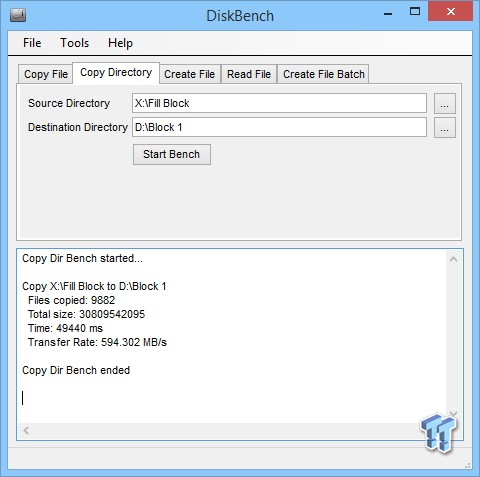
Read Transfer Rate
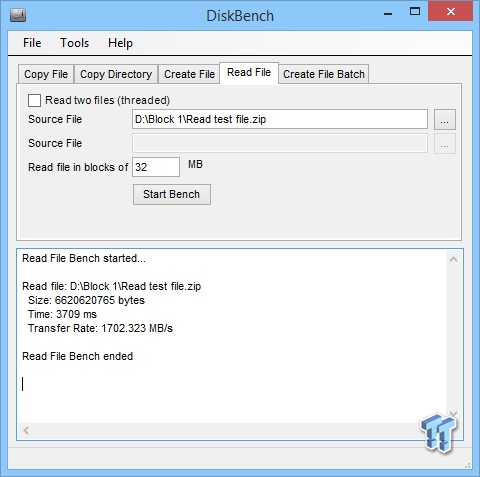
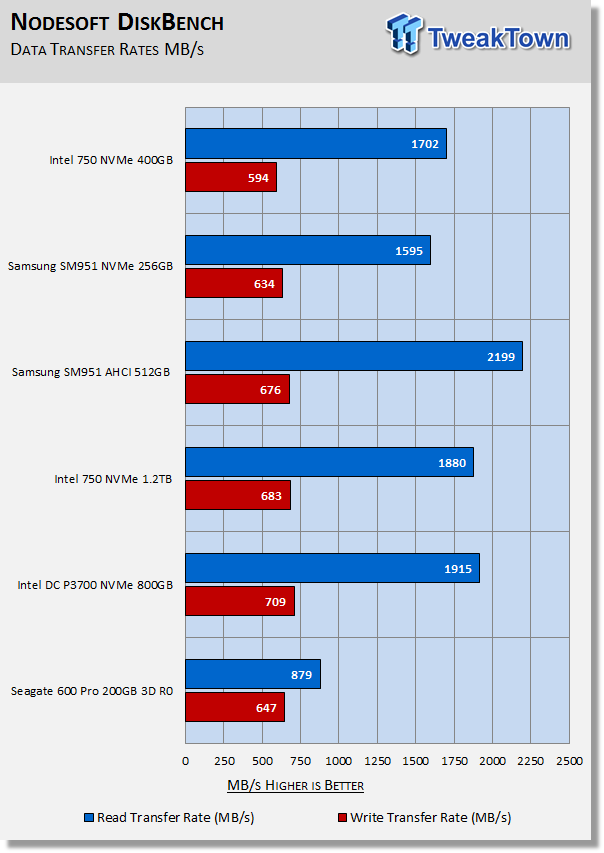
As we would expect, transfer rates are a bit lower with the 400GB 750 than the 1.2TB version.
Benchmarks (Secondary Volume) - PCMark 8 Extended
Futuremark PCMark 8 Extended
Heavy Workload Model
PCMark 8's consistency test simulates an extended duration heavy workload environment. PCMark 8 has built-in, command line executed storage testing. The PCMark 8 Consistency test measures the performance consistency and the degradation tendency of a storage system.
The Storage test workloads are repeated. Between each repetition, the storage system is bombarded with a usage that causes degraded drive performance. In the first part of the test, the cycle continues until a steady degraded level of performance has been reached. (Steady State)
In the second part, the recovery of the system is tested by allowing the system to idle and measuring the performance after 5-minute long intervals. (Internal drive maintenance: Garbage Collection (GC)) The test reports the performance level at the start, the degraded steady-state, and the recovered state, as well as the number of iterations required to reach the degraded state and the recovered state.
We feel Futuremark's Consistency Test is the best test ever devised to show the true performance of solid-state storage in an extended duration heavy workload environment. This test takes on average 13 to 17 hours to complete, and writes somewhere between 450GB and 14,000GB of test data depending on the drive. If you want to know what an SSD's steady state performance is going to look like during a heavy workload, this test will show you.
Here's a breakdown of Futuremark's Consistency Test:
Precondition phase:
1. Write to the drive sequentially through up to the reported capacity with random data.
2. Write the drive through a second time (to take care of overprovisioning).
Degradation phase:
1. Run writes of random size between 8*512 and 2048*512 bytes on random offsets for 10 minutes.
2. Run performance test (one pass only).
3. Repeat 1 and 2 for 8 times, and on each pass increase the duration of random writes by 5 minutes.
Steady state phase:
1. Run writes of random size between 8*512 and 2048*512 bytes on random offsets for 50 minutes.
2. Run performance test (one pass only).
3. Repeat 1 and 2 for 5 times.
Recovery phase:
1. Idle for 5 minutes.
2. Run performance test (one pass only).
3. Repeat 1 and 2 for 5 times.
Storage Bandwidth
PCMark 8's Consistency test provides a ton of data output that we use to judge a drive's performance.
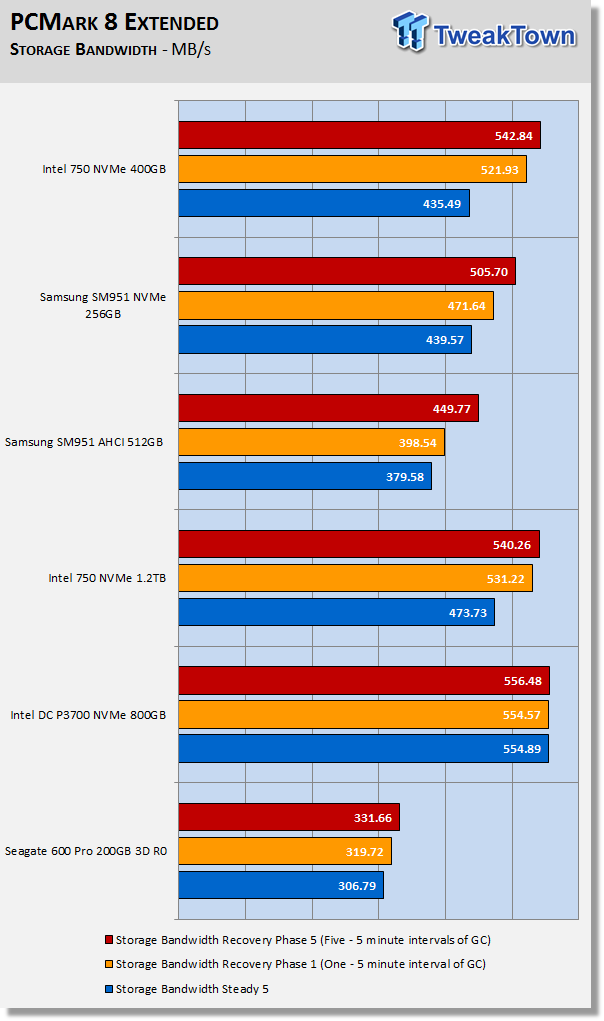
We consider steady state bandwidth (the blue bar) our test that carries the most weight in ranking a drive/arrays heavy workload performance. Performance after Garbage Collection (GC) (the orange and red bars) is what we consider the second most important consideration when ranking a drives performance. Trace based steady state testing is where true high performing SSDs are separated from the rest of the pack.
The 1.2TB 750 is able to outperform the 400GB in the heaviest of steady state workloads. After a little idle time to clean things up, the 400GB 750 is again just as fast as the 1.2 TB. During a steady-state heavy workload scenario, the 400GB 750 delivers performance on par with Samsung's NVMe drive.
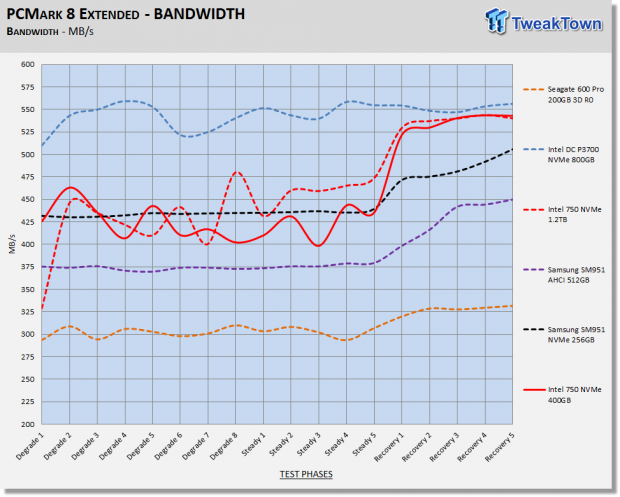
We chart our test subject's storage bandwidth as reported at each of the test's 18 trace iterations. This gives us a good visual perspective of how our test subjects perform as testing progresses.
Total Access Time (Latency)
We chart the total time the disk is accessed as reported at each of the test's 18 trace iterations.
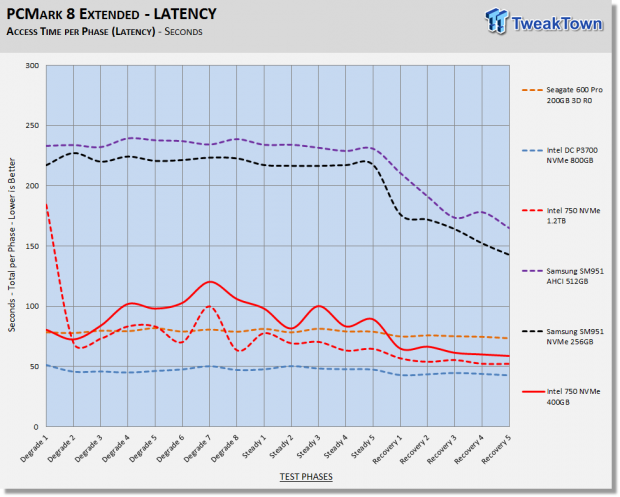
Disk Busy Time
Disk Busy Time is how long the disk is busy working. We chart the total time the disk is working as reported at each of the tests 18 trace iterations.
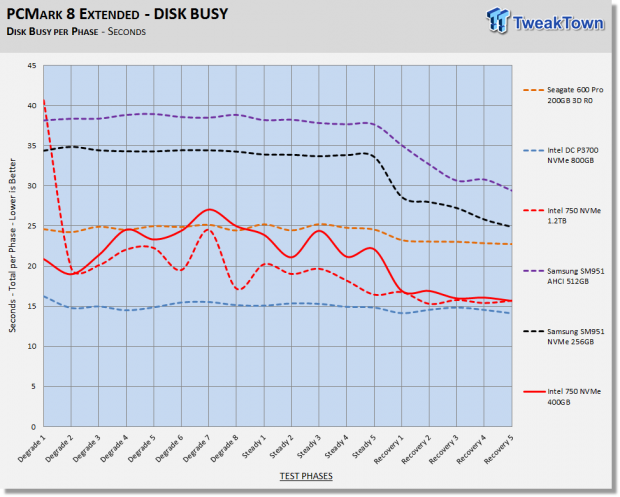
When latency is low, disk busy time is low as well.
Data Written
We measure the total amount of random data that our test drive/array is capable of writing during the degradation phases of the consistency test. Pre-conditioning data is not included in the total. The total combined time that degradation data is written to the drive/array is 470 minutes. This can be very telling. The better a drive/array can process a continuous stream of random data, the more data will be written.
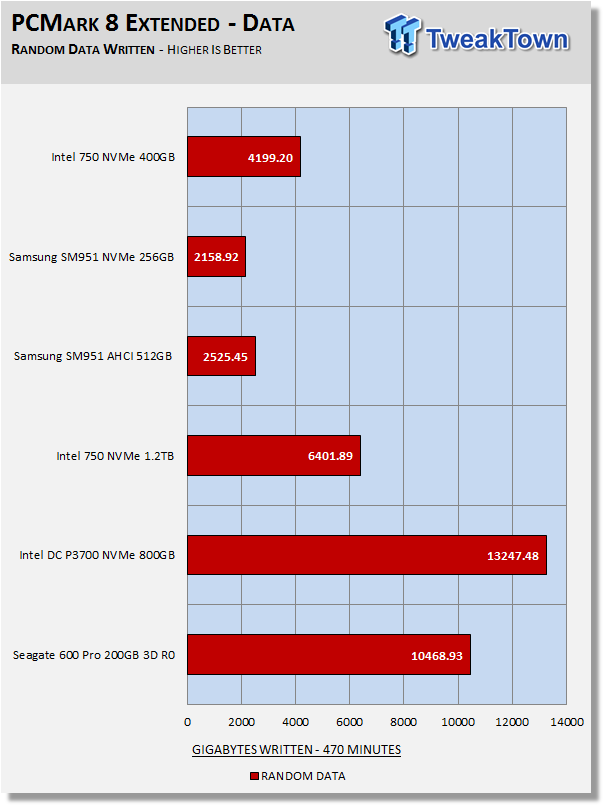
Enterprise class SSD's dominate this test.
Benchmarks (Secondary Volume) - 70/30 Mixed Workload
70/30 Mixed Workload Test (Sledgehammer)
Version and / or Patch Used: Iometer 2014
Heavy Workload Model
This test hammers a drive so hard we've dubbed it "Sledgehammer". Our 70/30 Mixed Workload test is designed to simulate a heavy-duty enthusiast/workstation steady-state environment. We feel that a mix of 70% read/30% write, full random 4K transfers best represents this type of user environment. Our test allows us to see the drive enter into and reach a steady state as the test progresses.
Phase one of the test preconditions the drive for 1 hour with 128K sequential writes. Phase two of the test runs a 70% read/30% write, full random 4K transfer workload on the drive for 1 hour. We log and chart (phase two) IOPS data at 5-second intervals for 1 hour (720 data points). 60 data points = 5 minutes.
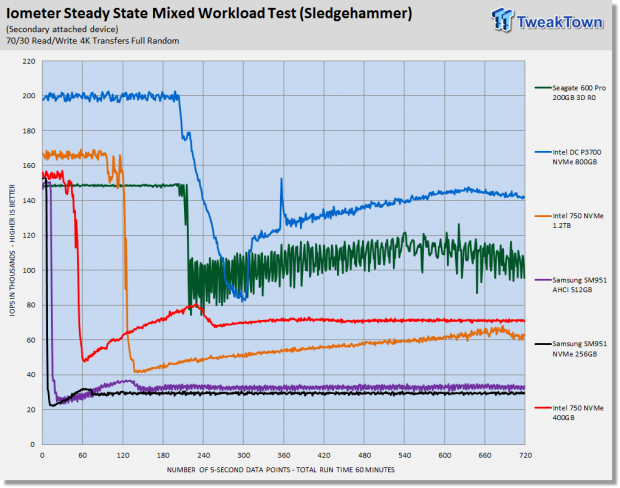
What we like about this test is that it reflects reality. Everything lines up, as it should. Consumer drives don't outperform Enterprise-Class SSD's that were designed for enterprise workloads. Consumer drives based on old technology are not outperforming modern Performance-Class SSD's, etc.
Better low queue performance gives the 400GB 750 a nice edge over the 1.2TB version in this demanding test, pointing to what we've been saying all along; the 400GB drive will likely deliver better performance as your OS disk than the 1.2TB will.
Maxed-Out Performance (MOP)
This testing is just to see what the drive is capable of in an FOB (Fresh Out of Box) state under optimal conditions. We are utilizing Windows Server 2008 R2 64-bit for this testing.
Intel 750 400GB NVMe SSD
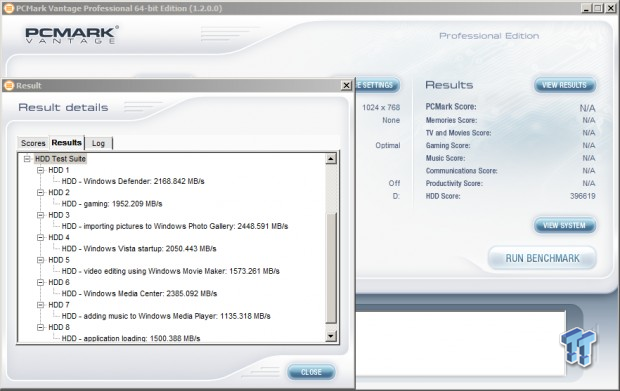
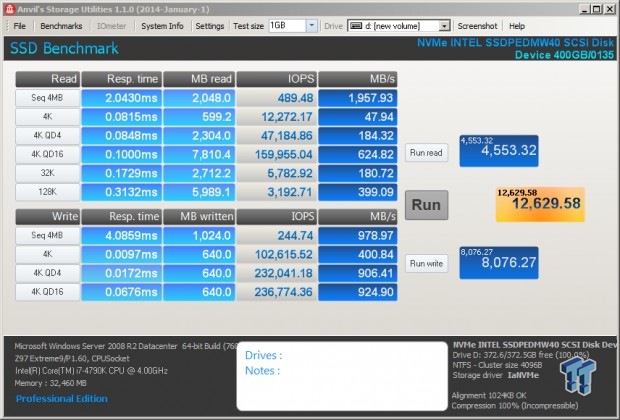
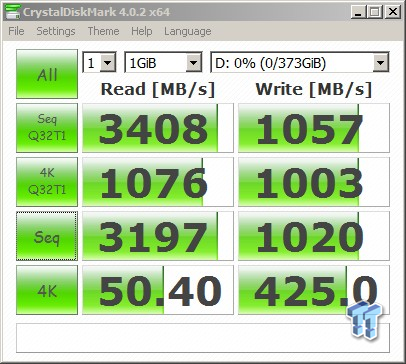
This is interesting. Look at that sequential read speed when QD32 is added to the mix. 3400MB/s is insanely fast and this is not just a one off occurrence as a secondary empty device, because we see the same thing when the drive is run as our OS disk with Windows 10 on our X99 setup.
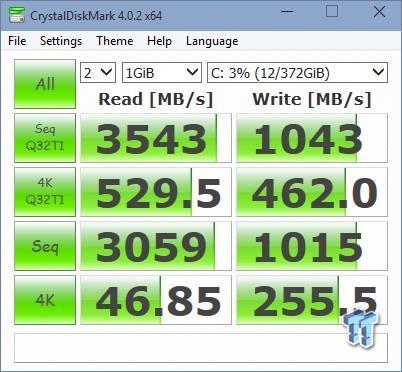
In-fact it's even faster on our X99 rig.
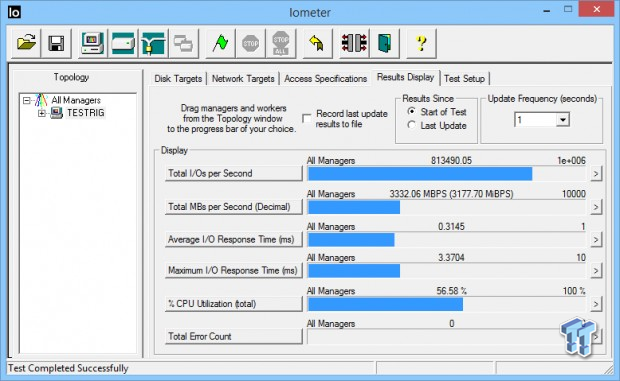
Here we have an Iometer run that backs up what we are seeing from the new version of CDM.
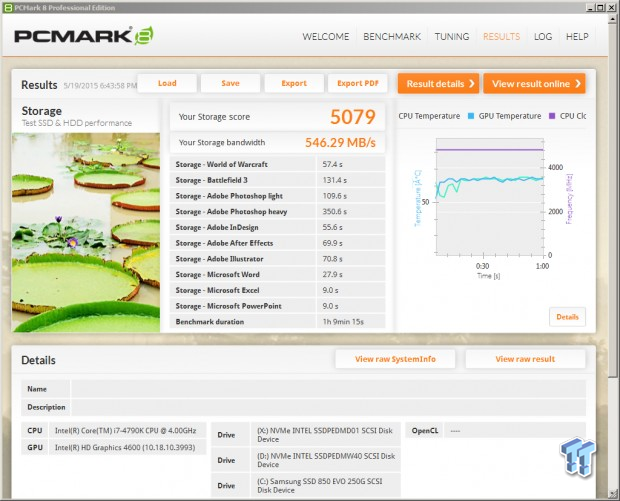
Intel 750 400GB NVMe SSD 2-Drive Soft RAID
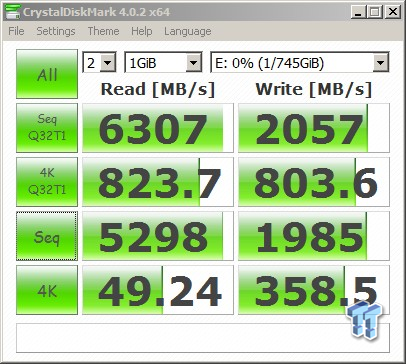
To further back up what we are seeing with regard to the incredible sequential read speed we are seeing from the 400GB 750 we soft RAIDed 2 of them and bam! 6300MB/s sequential read speed.
Final Thoughts
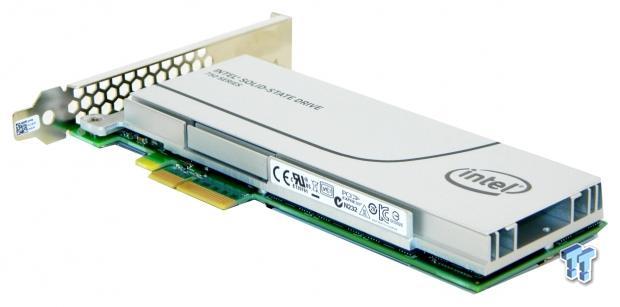
Intel introduced us to NVMe by first launching the 1.2TB 750. At that moment, SATA was instantly relegated to second tier performance; even our powerful SATA arrays are unable to perform on the same level as a single 750 Series NVMe PCIe drive. The only drawback is the $1000 price tag. Even though the 1.2TB 750 is still under a buck per gigabyte, the TCO is very high for most. Luckily, Intel makes an equally fast 400GB version. $400 bucks puts this drive into an affordable range for most enthusiasts, without compromising on performance. Equally fast at 1/3 the capacity is quite an accomplishment and a testament to Intel's engineering prowess.
Currently, Intel's 750 Series are the only consumer NVMe drive's available. Samsung's SM951-NVMe SSD is out there, but it's not available through normal retail channels, and even if you somehow get your hands on one, compatibility is a huge issue. You can almost be guaranteed that a Samsung SM951-NVMe SSD will have serious issues when utilized in a typical consumer build. Keep in mind, the SM951 is only qualified to run as advertised with specific OEM builds.
On the other hand, Intel's 750 Series SSD is more than just speed, it's rock solid. It just works on any Intel X99 or Z97 platform with the latest BIOS installed. In addition, we love that Intel has their own driver. This allows the 750 series to be installed as your OS disk with Windows 7 or Server 2008 by just installing the standalone driver when you install Windows.
Because we perform most of our evaluations with the test subject running as our boot volume, we can comment on how the drive performed with our OS. We do experience slightly slower boot times, but nothing that is any sort of drawback; we are talking like 2-3 seconds difference in comparison to a SATA SSD. Once Windows is loaded, you can feel a big difference loading programs, loading is notable faster than anything you have ever experienced; especially games with long load times. If you install programs from and to the 750, it's so fast you will wonder if something is wrong because it installed so fast. Overall, the 750 Series SSD is changing the definition of what it means to have a fast computer.
Once again, Intel is first with new technology. NVMe is changing the computer world and Intel is leading the charge with their 750 Series SSD's. $400 is not much to change your computing experience in a massive way. We feel that Intel's newest SSD is necessity for any hardcore enthusiast and we are confident that you will be happy you spent your hard-earned money on one.
Pros:
- Highest in class IOPS
- Extensive compatibility
- Reasonably priced
Cons:
- Form factor

